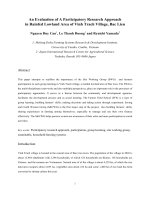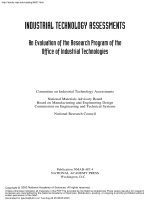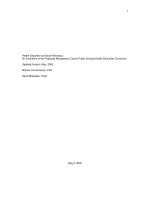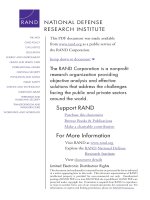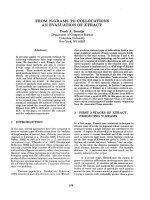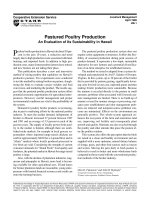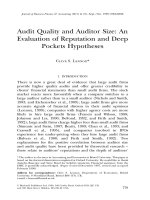an evaluation of communication strategy instructions
Bạn đang xem bản rút gọn của tài liệu. Xem và tải ngay bản đầy đủ của tài liệu tại đây (972.02 KB, 52 trang )
i
CAN THO UNIVERSITY
SCHOOL OF EDUCATION
ENGLISH DEPARTMENT
AN EVALUATION OF
COMMUNICATION STRATEGY INSTRUCTIONS
Trung tâm Học liệu ĐH Cần Thơ@Tài liệu học tập và nghiên cứu
B.A. Thesis
Supervisors: Trinh Quoc Lap
Researcher:
Duong Thi Phi Oanh
Can Tho, June 2007
Nguyen Thi Van Su
Code: 7032464
B.Ed. class NN0352A3
Course 29
An Evaluation of Communication Strategy Instructions i
CONTENTS
Contents .......................................................................................................................................i
Acknowledgements ....................................................................................................................iii
Abstract .....................................................................................................................................iv
List of Tables of Figures .............................................................................................................v
Chapter 1 Introduction ........................................................................................................1
1.1 Rationale ..............................................................................................................1
1.2 Research aims ........................................................................................................2
1.3 Organization of the thesis ......................................................................................2
Chapter 2 Literature Review ..................................................................................................3
2.1 Communicative competence ..................................................................................3
2.2 Strategic competence .............................................................................................5
2.2.1 Definition ...................................................................................................5
2.2.2 Strategic competence – an important component of
communicative competence ................................................................................7
2.3 Communication strategies and the significance of Communication
Strategy Instructions (CSIs) ........................................................................................7
2.3.1. Definition ..................................................................................................8
2.3.2. Taxonomy .................................................................................................8
2.3.3 The significance of communication strategy instructions .......................10
Chapter 3 Research Methodology ........................................................................................15
3.1Học
Research
question
................................................................................................15
Trung tâm
liệu
ĐH Cần
Thơ@Tài liệu học tập và nghiên cứu
3.2 Research design ...................................................................................................15
3.3 Participants ..........................................................................................................16
3.3.1 Teachers ...................................................................................................16
3.3.2 Students.....................................................................................................17
3.3.3 Observers..................................................................................................17
3.4 Materials ............................................................................................................17
3.5 Instruments ..........................................................................................................18
3.5.1 Textbook evaluation criteria.....................................................................19
3.5.2 Classroom Observation Sheet ..................................................................19
3.5.3 Questionnaires for teachers ....................................................................20
3.5.4 Questionnaire for students .......................................................................21
3.6 Procedure ............................................................................................................22
3.6.1 Evaluating the textbook ............................................................................23
3.6.2 Observing the seven GE 4 classes ............................................................23
3.6.3 Administering questionnaires for teachers and students..........................23
Chapter 4 Results ..................................................................................................................25
4.1 The manifestation of CSIs from unit 30 to 40 in Reward Elementary (Greenall
and Pye, 1997) ............................................................................................................25
4.1.1 The mean scores of the evaluation of the student’s book and
workbook ...........................................................................................................25
4.1.2 The mean scores of the evaluation of the teacher’s book ........................26
4.2 The instructions of communication strategies in the classroom .........................27
An Evaluation of Communication Strategy Instructions ii
4.3 Teachers’ perceptions of CSIs in learning and teaching and teachers’
opinions about the significance of CSIs .....................................................................29
4.3.1 Teachers’ perceptions of CSIs in learning and teaching .........................29
4.3.2 Teachers’ opinions about the significance of CSIs ..................................30
4.4 Students’ frequency of communication strategy use ............................................31
Chapter 5 Discussions, Limitations, and Suggestions for Further Research ...................34
5.1 Discussions ..........................................................................................................34
5.1.1 Theoretical findings..................................................................................34
5.1.2 The empirical research into the inclusion of CSIs in the curriculum
of GE.................................................................................................................35
5.1.3 Pedagogical implications.........................................................................37
5.2 Limitations and Suggestions for further research ................................................38
Bibliography ............................................................................................................................39
Appendices ..............................................................................................................................41
Appendix 1 Textbook Evaluation Criteria ................................................................41
Appendix 2 Observation sheet...................................................................................43
Appendix 3 Questionnaire for teachers .....................................................................44
Appendix 4 Questionnaire for students .....................................................................46
Appendix 5 Bảng câu hỏi cho sinh viên ....................................................................48
Trung tâm Học liệu ĐH Cần Thơ@Tài liệu học tập và nghiên cứu
An Evaluation of Communication Strategy Instructions iii
ACKNOWLEDGEMENTS
During the time I conducted the thesis, I have got the help and support from many people from
whom I would like to sincerely thank and acknowledge.
First, I would like to express the deepest gratitude to my supervisors Mr. Trinh Quoc
Lap and Mrs. Duong Thi Phi Oanh, for their valuable insights, comments, and suggestions.
Without their guidance, my thesis would hardly have been completed. I am solely responsible
for any remaining errors in the thesis.
Second, many special thanks are sincerely sent to the seven instructors and students of
the classes that I observed. I also want to express my appreciation to the instructors that helped
me to evaluate the textbook and the instructors who gave me helpful suggestions when
piloting the instruments. Their generous willingness in participating in the study was the
Trung tâm Học liệu ĐH Cần Thơ@Tài liệu học tập và nghiên cứu
invaluable help for me. My special thanks also go to Ms. Bui Lan Chi, Ms. Phuong Hoang
Yen, Mr. Nguyen Viet Tien, teachers of the English Department, CTU, for their utmost help at
the beginning of my thesis.
Third, I am very grateful to my friends Nguyen Thi Hong Uyen, Le Ngoc Thu Trung,
Le Nhu Ngoc Ha, and Vo Minh Nha who spent their precious time observing the classes with
me, and suggested me many interesting materials related to the research.
I also want to thank many others for being always by my side and giving me timely
support. Many thanks are also owed to my family for giving me the best conditions to study
and complete the thesis.
An Evaluation of Communication Strategy Instructions iv
ABSTRACT
The study investigates whether and if yes, to which degree communication strategy
instructions (henceforth CSIs) are included in the curriculum of General English 4 at Cantho
University (CTU). The research samples are 7 teachers and 226 students of 7 General English
4 classes at CTU, 8 textbook evaluators, who are teachers of the English Department at CTU,
and 2 senior English major students, who participated in the study as classroom observers. The
four instruments of the study consist of Textbook evaluation criteria, Classroom observation
sheet, Questionnaire for teachers, and Questionnaire for students. The results indicate that (1)
CSIs are not clearly manifested in the textbook, (2) although the teachers, in general, were
aware of the significance of CSIs and supported CSIs, the implementation of CSIs of the
Trung
tâm
Học
liệu ĐH
Cần
liệu
tập và
cứu
teachers
in the
classroom
practice
was Thơ@Tài
rather limited and
(3) học
the students
just nghiên
had an average
frequency of communication strategy use. From the results of the study, I put forward some
recommendations to implement more CSIs in the classroom practice.
An Evaluation of Communication Strategy Instructions v
LISTS OF TABLES AND FIGURES
Table/Figure
Page
Table 3.1: Information about the observed Teachers and General English 4 classes ...............16
Table 3.2: Items in sections of questionnaire for teachers ........................................................20
Table 3.3: Items in sections of questionnaire for students ........................................................21
Table 4.1: The mean scores of the evaluation of the student’s book and workbook collected
from 8 evaluators .....................................................................................................26
Table 4.2: The mean scores of the evaluation of the teacher’s book collected from 3
evaluators.................................................................................................................27
Table 4.3: Types of CSs and the approaches to CSIs in the classroom ....................................27
Table 4.4: Descriptive Statistics of Teacher’s perceptions of CSIs ..........................................29
Table 4.5: Teachers’ opinions about the significance of CSIs ..................................................30
Table 4.6: Descriptive Statistics of Students’ frequency of communication strategy use ........31
Table 4.7: The mean score for the frequency of each communication strategy use .................32
Figure 2.1: The taxonomy of communication strategies (Tarone, 1983) ..................................10
Figure
4.1: The
mean
of teachers’
perceptions
of CSIs ...........................................................30
Trung
tâm
Học
liệu
ĐH Cần
Thơ@Tài
liệu học tập và nghiên cứu
Figure 4.2: The mean of students’ frequency of communication strategy use..........................32
An Evaluation of Communication Strategy Instructions
1
CHAPTER 1
INTRODUCTION
Effective strategies used to overcome communication difficulties are extremely important for second
language (L2) learners (Faucette, 2001). Accordingly, the instructions on how to deal with such communication
difficulties may somehow benefit L2 learners. Since the early 1980’s, many studies have been conducted on the
instructions of communication strategies, the means which L2 learners resort to in order to express an intended
meaning. The results of these studies generally advocate the teaching of communication strategies (e.g., Dörnyei
1995; Dörnyei & Thurrell, 1991, 1994; Tarone, 1983). Therefore, it is necessary to examine the inclusion of
communication strategy instructions in the curriculum of L2 learners.
1.1 Rationale
According to some of the instructors who are teaching General English at Cantho
University,
English
usually have limited
resource
and therefore,
Trung
tâm non-major
Học liệu
ĐH students
Cần Thơ@Tài
liệu language
học tập
và nghiên
cứu
have difficulties communicating in English. When they are asked to speak in English, many of
them find it difficult to express their ideas and usually just keep silent.
For English major students, with the textbooks Interaction and Mosaic (Mcgraw-Hill,
1997) they have learned some techniques to get over communicative failures such as
paraphrasing, appealing for help from the teacher... These techniques belong to
communication strategies which are defined as “a systematic technique employed by a speaker
to express his meaning when faced with some difficulty” (Corder, 1983). According to
Rababah (2001), communication strategies help language learners cope with communication
problems they encounter and can help them succeed in communication. Some communication
strategies are presented in the textbook of English major students (Interactions and Mosaic)
and these students are instructed to use communication strategies to get over communication
problems, how about non-major students? Whether communication strategies are instructed
An Evaluation of Communication Strategy Instructions
2
for non-major students in their General English classes in order to help them tackle difficulties
in communication? To find the answer for this question, a research on the inclusion of CSIs in
the curriculum of non-major students at Cantho University was conducted.
1.2 Research aims
The study was done in order to find out whether CSIs are included in General English
curriculum at CTU. If CSIs are included, the study will aim to investigate the degree to which
they are included in the curriculum. From the obtained results, some pedagogical implications
for English teachers as well as curriculum developers of General English at CTU will be
suggested.
1.3 Organization of the thesis
The report of the study in this thesis consists of five chapters: Introduction, Literature
Trung tâm Học liệu ĐH Cần Thơ@Tài liệu học tập và nghiên cứu
review, Research methodology, Research results, and Discussions, Limitations and
Suggestions for further research. In chapter 1, research rationale, research aims and the
structure of the research are introduced. In chapter 2, I will summarize some studies relevant
to the research. More specifically, the definitions of communicative competence, strategic
competence and communication strategies will be presented, followed by the discussion about
the significance of CSIs. In chapter 3, I will present the methodology of the research by
describing the research design, the participants, the materials, the research instruments, and the
procedure of conducting the research. In chapter 4, the results of the study will be reported. In
chapter 5, I will present the discussions withdrawn from the analyzed data, the limitations of
the study and some suggestions for further research.
An Evaluation of Communication Strategy Instructions
3
CHAPTER 2
LITERATURE REVIEW
In learning an L2, besides phonological, lexical, and grammatical knowledge, it is necessary for learners
to know the ways how to communicate with others using the target language. As a result, language teachers and
curriculum developers worldwide have implemented communication-oriented teaching syllabi to seek for more
effective ways to enhance students’ communicative competence. In this chapter, I present (1) the definition and
the components of communicative competence, (2) strategic competence - one important component of
communicative competence, and (3) communication strategies (henceforth CSs) and the significance of
communication strategy instructions (CSIs) in language teaching and learning.
2.1 Communicative competence
Recently, the ultimate goal of language learning, put in any context of teaching and
learning English as a foreign language, has been attributed to the ability to communicate
Trung
tâm Học liệu ĐH Cần Thơ@Tài liệu học tập và nghiên cứu
competently, not to use the language as accurately as native speakers do. Therefore, in the past
decades, linguists and language teaching experts have paid much attention to Communicative
Competence, which is regarded as the knowledge enabling someone to use a language
effectively and their actual ability to use this knowledge for communication (Johnson &
Johnson, 2001). It has become widely accepted that communicative competence should be the
goal of language education, central to good classroom practice (Savignon 1998). According to
Canale and Swain's (1980) and later Canale's (1983), there are four different components that
make up communicative competence: grammatical competence, discourse competence,
sociolinguistic competence and strategic competence.
An Evaluation of Communication Strategy Instructions
4
1. Grammatical competence. As defined by Canale and Swain (ibid.), grammatical
competence is the knowledge of linguistic rules, including the four areas of grammar: syntax the sentence patterns of language, phonology - the system of sound patterns, morphology - the
formation of words, and semantics - the understanding of word’s meanings. Grammatical
competence, therefore, asks such questions as: What words should we use? How do we put
them into phrases and sentences?
2. Discourse competence. Canale and Swain (ibid.) regarded discourse competence as
the knowledge of how to use a language cohesively and coherently. Discourse competence,
consequently, asks such question as: What pronouns or grammatical connectors should we use
to connect ideas or put sentences together?
3. Socio-linguistic competence. According to Canale and Swain (ibid.), socio-linguistic
Trung tâm Học liệu ĐH Cần Thơ@Tài liệu học tập và nghiên cứu
competence is knowing how to use and respond to language appropriately, given the setting,
the topic, and the relationships among the people communicating. In other words, sociallinguistic competence asks: Which words and phrases fit a certain setting and topic? How can
we express a specific attitude (courtesy, authority, friendliness, respect)? How do we know
what attitude another person is expressing?
I have just presented the definition, the four components of communicative competence,
and the descriptions of its three first components. The other component - strategic competence
- will be discussed in detail in the following part - 2.2 Strategic competence.
2.2 Strategic competence
An Evaluation of Communication Strategy Instructions
5
2.2.1. Definition
Dörnyei and Thurrell (1991) defined strategic competence as the ability of the learners
in successfully understanding their communicative partners’ meaning, especially when
problems occur in the process of communication while Tarone and Yule (as cited in Ghaleb,
2001) believed that strategic competence includes the ability to select the effective means to
perform a communicative act when encountering communication failures. Hence, combining
these two definitions, it can be assumed that strategic competence refers to the learners’ skill
in (1) transmitting the message successfully and comprehensively to the listeners and (2)
understanding the information received. This viewpoint of strategic competence is in line with
that of Canale and Swain (ibid.) who asserted that strategic competence is the learners’
attempt to “overcome difficulties when communication breakdowns occur”. To Canale and
Swain (ibid.), these communication breakdowns could stem from either the learners’ limited
Trung tâm Học liệu ĐH Cần Thơ@Tài liệu học tập và nghiên cứu
linguistic knowledge such as the lack of structures and vocabulary or the learners’
performance variables (fatigue, nervousness). In addition, Canale and Swain (ibid.) also stated
the components of strategic competence, comprising both verbal and non-verbal
communication strategies. The concept of CSs will be discussed in more details in section 2.3Communication strategies and the significance of Communication Strategy Instructions.
2.2.2 Strategic competence – an important component of communicative competence
In the article “Strategic Competence and Language Teaching” (2001), Rababah
claimed that teachers of English have been focusing on the three first components of
communicative competence but have paid little or even no attention to strategic competence
since they believe that once grammatical competence, sociolinguistic competence and
discourse competence are developed, language learners will be able to communicate
effectively in the real world. However, Rababah stressed the importance of strategic
competence as a necessary part of communicative competence. Along with Rababah (ibid.),
An Evaluation of Communication Strategy Instructions
6
many other linguists also emphasized the major role of strategic competence in successful
communication.
Similar to Rababah (ibid.), Tarone (1983) and Savignon (1987) also vigorously
supported the important role of strategic competence in communicative competence. To these
two linguists, every component of communicative competence, including strategic
competence, is extremely important in the foreign language classroom. More specifically,
regardless of experience and level of proficiency, “one never knows all a language”
(Savignon, 1987). Therefore, it is obvious that the learners’ ability to cope with linguistic
limitation is extremely important. Due to the importance of strategic component, Mariani
(1994) strongly affirmed that “strategic competence provides many advantages for learners; as
a consequence, strategic competence should be a significant component of an EFL 1 syllabus.”
All in all, it can be concluded that strategic competence constitutes an important aspect
Trung tâm Học liệu ĐH Cần Thơ@Tài liệu học tập và nghiên cứu
of communicative competence. As Canale and Swain (ibid.) stated, strategic competence
comprises communication strategies. Correspondingly, it is necessary to find out what
communication strategies are and what benefits the instructions of these strategies provide for
language learners.
2.3 Communication strategies (CSs) and the significance of Communication Strategy
Instructions (CSIs)
2.3.1. Definition
Different linguists defined the phrase “communication strategies” differently (Tarone,
1983; Fearch and Kasper, 1983; Brown, 1987). The following definitions are attempted to
provide an insightful look into the nature of communication strategies.
Tarone (1983) defined the phrase “communication strategies” as:
1
English as a Foreign Language
An Evaluation of Communication Strategy Instructions
7
“a systematic attempt by the learners to express or decode meaning in the target language, in
situations where the appropriate systematic target language rules have not been found (p.5)”
Fearch and Kasper (1983), on the other hand used the word “plan” instead of “attempt”
as Tarone to define CSs because they assumed that the execution of a “plan” would lead to
verbal behavior which is expected to satisfy learners’ communication goal. They defined the
term “communication strategies” in the following way:
“Communication strategies are potentially conscious plans for solving what to an individual
presents itself as a problem in reaching a particular communicative goal (p.36).”
Later, Brown (1987) defined the phrase as follows:
“the conscious employment by verbal or non-verbal mechanisms for communicating an idea
when precise linguistic forms are for some reason not available to the learner at the point in
communication (p. 180).”
Although
phrase
“communication
strategies”
was học
defined
differently,
it is evident
Trung tâm
Họctheliệu
ĐH
Cần Thơ@Tài
liệu
tập
và nghiên
cứu
that the two principal defining criteria for CSs, as suggested by Fearch and Kasper (1983) and
Brown (1987) are “problematicality” and “consciousness”. In other words, the aforementioned
definitions seem to support the claim that communication strategies are consciously employed
by L2 learners to achieve communication goals when the learners face communication
problems due to linguistic shortcomings.
2.3.2. Taxonomy
The taxonomy of CSs is various since new taxonomies are developed by linguists and
researchers from time to time. In this study, the taxonomy of Tarone (1977) and further
elaborated by Tarone (1983:62-63) is presented since it is brief, standard and “is considered
the basis of all proposed taxonomies” (Rababah, ibid.). According to Tarone, CSs can be
divided into three main groups: paraphrase, borrowing/conscious transfer, and avoidance.
An Evaluation of Communication Strategy Instructions
8
1. Paraphrase. Paraphrase is used to express the same ideas in a different way in the
target language. According to the taxonomy of Tarone (1983), paraphrase is divided into
three parts. First, approximation means that the learner uses a single target language
vocabulary item or structure, which he/she knows is not correct, but shares enough semantic
features with the targeted item. For instance, the learner might use the word “spoon” in place
of the word “fork”. Second, word coinage is the creation of a new word, which is used to
communicate a desired concept. For example, the learner might say “typer” instead of
“typist”. Lastly, circumlocution is used by learners to describe the characteristics or elements
of the objects or action instead of using the appropriate target language item or structure. For
example, the learner might say “become water” if he/she does not know the word “melt”.
2. Borrowing/Conscious transfer. To Tarone (1983), this group comprises learners’
using their native language, miming or asking for help from the interlocutors to express their
Trung tâm Học liệu ĐH Cần Thơ@Tài liệu học tập và nghiên cứu
thoughts. It is categorized into four aspects. The first aspect is literal translation, which is
used to translate word for word from the native language. For example, a Vietnamese learner
might translate the intended phrase “go under the rain” as “walk in the rain” to express his
meaning. The second aspect of borrowing/conscious transfer is language switch, which
means that learners insert words from other languages when expressing their ideas without
bothering to translate. For example, learners might use the word “cravate”- a French word
when they do not know the word “tie” in English. The third aspect of this group is appeal for
assistance, which means that learners ask for the correct term from their communicative
partners instead of solving problems by themselves. For instance, learners can use the
following phrases to ask for repetitions from the speakers: I beg you pardon, Could you say
that again?, Do you mean...?... The last aspect of borrowing/conscious transfer is mime,
which is used to express ideas through body language or gestures. For example, learners
might repeatedly curl and uncurl their fingers to indicate “come here”.
9
An Evaluation of Communication Strategy Instructions
3. Avoidance. Avoidance means that learners bypass using certain words or grammar
structures. Avoidance, according to Tarone (1983), is divided into two main parts. The first
part, topic avoidance, means that the learner simply tries not to talk about concepts for which
the target language item or structure is not known. For example, a learner may ignore
religious discussions if he/she is not sure of a topic or if it requires him/her to use a more
extensive, advanced vocabulary. The leaner can then switch to another topic that he/she is
more interested in by using phrases such as: by the way, talking about... The second part of
avoidance is message abandonment, which means that learners are unable to continue and
stop in mid-utterance when talking about a certain concept. For example: It is a person...er...
who is responsible for a house, for the block of house... I don’t know...
The taxonomy by Tarone (1983) can be summarized by the figure in the following page.
Trung tâm Học liệu ĐH Cần Thơ@Tài liệu học tập và nghiên cứu
COMMUNICATION
STRATEGIES
PARAPHRASE
BORROWING/
CONSCIOUS TRANSFER
AVOIDANCE
Approximation
Literal translation
Topic avoidance
Word coinage
Language switch
Message
abandonment
Circumlocution
Appeal for
assistance
Mime
An Evaluation of Communication Strategy Instructions
10
Figure 2.1 The taxonomy of communication strategies (Tarone, 1983)
As mentioned in 2.2.1 Definition of strategic competence, Canale and Swain (ibid.)
emphasized that both verbal and non-verbal CSs constitute strategic competence - a crucial
component of communicative competence. Thereby, it can be assumed that CSs provide L2
learners a lot of benefits and contribute to learners’ ability to communicate competently. As a
result, the instructions of CSs should be fostered in the classroom context. The following part
will discuss what benefits the instructions of CSs can provide language learners.
2.3.3 The significance of communication strategy instructions (CSIs)
The instructions of CSs can benefit language learners in four main ways: (1) help
learners solve communication problems and achieve their communication goals, (2) facilitate
language learning, (3) maintain conversations, and (4) enhance learners’ strategic competence
Trung
tâm Học liệu ĐH Cần Thơ@Tài liệu học tập và nghiên cứu
and communicative competence. These benefits of CSIs will be more specifically presented in
the following section.
Firstly, CSIs can help language learners solve communication problems and achieve
their communication goals (Rababah, 2001). Rababah emphasized that the use of CSs does not
mean language learners fail to communicate in English. On the other hand, the use of CSs can
be an efficient way to compensate for the lack of linguistic knowledge and help language
learners overcome problems in communication due to performance variables such as fatigue,
nervousness or insufficient competence. When faced with such communication difficulties,
learners may try to avoid particular language items, paraphrase when they do not have the
appropriate form, ask for help from the speakers/listeners, or even use gestures to
communicate the intended meanings, etc.... Thus, Rababah (ibid.) recommended that CSIs
should be paid more attention in the classroom context. Rababah’s viewpoint on the
importance of CSIs is in agreement with that of Tarone (1983). Tarone asserted that not only
An Evaluation of Communication Strategy Instructions
11
students’ skill in conveying information successfully is important, students’ abilities to use
CSs when the process of conveying information encounters a problem is important as well.
For this reason, Tarone claimed that in the first place, communicative classroom materials and
exercises should concentrate more on student's CSs and in the second place, “teachers can
encourage students to use these strategies by providing both opportunities for practice and
actual instruction in their use.”
Secondly, according to Oxford (as cited in Faucette, 2001) CSIs will lead to learning.
When language learners are directly instructed on CSs, they are more likely to use these
strategies to elicit unknown language items from the interlocutor. Therefore, learners can
receive more input during communication process and this input helps them widen their
knowledge and motivates them to communicate more confidently. For instance, when talking
to someone, one learner might say “a machine that cleans the floor” to imply the “vacuum
Trung tâm Học liệu ĐH Cần Thơ@Tài liệu học tập và nghiên cứu
cleaner”. His/her communicative partner will easily understand him/her and probably say: you
mean a “vacuum cleaner”? In this case, it is clear that the learner can learn a new word from
his/her communicative partner and next time, if he/she wants to say “vacuum cleaner”, he/she
does not have to resort to any CSs to say the right word. Indeed, different studies on the
training of CSs have significantly supported the fact that CSIs can facilitate language learning
(Rababah, 2001; Faucette, 2001). Accordingly, Oxford (as cited in Faucette, 2001) believed
that teachers should directly teach CSs in order to help learners become more aware of how to
use such strategies for more effective communication and therefore, enhance their language
learning process.
Besides helping language learners solve communications problems and facilitating
language learning, CSIs can also help learners maintain their conversations. Larsen-Freeman
and Long (1991) regarded CSs as a vital tool to maintain conversation, especially for less
proficient learners. When learners are able to maintain the conversations, they can benefit
12
An Evaluation of Communication Strategy Instructions
from receiving more additional modified input. On the other hand, if learners easily give up
expressing their ideas due to inadequate linguistic resource without resorting to any CSs, their
conversational ability is unlikely to be developed. By using CSs, communication channel will
remain open and learners can stay longer in the conversation. As a consequence, it seems
necessary to introduce the instruction on CSs as recommended by Faucette:
“Teaching recommended communication strategies empowers students to participate in communication
by helping them to not give up in the conversation. We as teachers have a responsibility to provide our
students with tools to communicate...”
Faucette (2001)
Furthermore, according to Færch & Kasper (1986), Tarone & Yule (1989); Chen (1990),
Dörnyei & Thurrell (1991), CSIs are significant because they can develop learners’ strategic
competence and communicative competence. To these researchers, the language teacher’s first
task is
to train
learners
better
communication,
not liệu
for perfection.
Thevà
appropriate
of
Trung
tâm
Học
liệuforĐH
Cần
Thơ@Tài
học tập
nghiênusecứu
CSs will compensate for errors that learners may make in their interaction. As CSs constitute
strategic competence (Canale and Swain, ibid.), when learners are able to use CSs fluently and
effectively to compensate for their linguistic knowledge, their strategic competence must be
developed. What is more, since strategic competence has been stressed as an important
component of the communicative competence, the improvement of strategic competence could
result in the improvement in learners’ communicative competence (S. Q. Chen, 1990 and
Dörnyei, 1995). In particular, Chen conducted an empirical study on CSs in interlanguage
production by Chinese EFL learners to test whether CSIs can help learners enhance their
communicative competence. From the results of the study, Chen stated that learners’ strategic,
and
therefore,
communicative
competence
could
probably
be
enhanced
through
communication strategy training. The improvement of communicative competence through
CSIs was later affirmed in another study of Dörnyei (1995). From his study, Dörnyei indicated
An Evaluation of Communication Strategy Instructions
13
that CSIs are beneficial for second language learners in three different ways: raise awareness
of CSs, provide training in how to use these strategies properly in L2, and provide
opportunities for communication strategy practice which can help learners develop second
language communicative competence (Dörnyei, 1995, pp. 62-64). Thus, Dörnyei emphasized
that learners’ use of CSs should be developed through focused instruction.
In brief, from this review of the literature on CSIs, it becomes clear that
communication strategy training provides language learners many positive impacts, especially
on their language learning process. Since second language learners are more likely to face
communication problems due to their lack of language resource needed to communicate their
intended goal, many researchers strongly recommend the introduction of CSIs in a language
teaching curriculum (Dörnyei and Thurrell, 1991; Dörnyei, 1995; Corder, 1983). Thus, in
situations where language curriculum and course content are to be designed for non-native
Trung tâm Học liệu ĐH Cần Thơ@Tài liệu học tập và nghiên cứu
speaking background learners, the instructions of CSs should be focused. However, according
to Dörnyei and Thurrell (1991), practicing teachers are usually unaware of the significance of
CSIs, and “hardly any activities have been developed to include strategy training in actual
language teaching.” Moreover, Tarone and Yule (as cited in Rababah, 2001) found that “there
are few, if any, materials available at present which teach learners how to use communication
strategies”. To examine whether curriculum designers and teachers have recently paid more
attention to CSIs, it is; therefore, necessary to investigate the inclusion of CSIs in the
curriculum of L2 learners.
CHAPTER 3
RESEARCH METHODOLOGY
The previous chapter reviewed the literature related to communicative competence, strategic
competence, communication strategies and the significance of CSIs. The results from the literature review
An Evaluation of Communication Strategy Instructions
14
showed that CSIs can benefit language learners in different ways and the instructions of communication
strategies should be included in the L2 classroom curriculum accordingly. In this chapter, I will present the
methodology of the research, which comprises (1) the research question, (2) the research design, (3) the
participants, (4) the materials, (5) the research instruments, and (6) the procedure of the research.
3.1 Research question:
Regarding the significance of CSIs in promoting learners’ communicative competence,
this investigation mainly addresses the following research question:
“Are CSIs included in the General English (GE) 4 curriculum at CTU, and if yes, to
which degree CSIs are included in the curriculum?”
3.2 Research design
The study followed a descriptive design. According to Herbert and Elana (1989)
descriptive
is used
to establish
the existence liệu
of phenomena
by explicitly
describing
Trung
tâm research
Học liệu
ĐH
Cần Thơ@Tài
học tập
và nghiên
cứu
them. In the present study, the inclusion of CSIs in GE curriculum at CTU is investigated. The
independent variable in this study is the inclusion of CSIs in GE curriculum at CTU and
learners’ communicative competence is the dependent variable.
3.3 Participants
3.3.1 Teachers
Seven teachers of the English Department at CTU who were teaching GE 4 at CTU
participated in the research. I henceforth refer them as Teacher 1, Teacher 2, Teacher 3,
Teacher 4, Teacher 5, Teacher 6, and Teacher 7. Five out of the teachers obtain an M.A.
degree in language teaching and the other two hold a B.A. degree in language teaching.
Teacher 3 and Teacher 4 have been teaching English for two and three years respectively
15
An Evaluation of Communication Strategy Instructions
while the other teachers have more than eight-year experience teaching English. Table 1
summarizes information about the seven teachers and the observed GE 4 classes they taught.
Table 3.1 Information about the observed Teachers and General English 4 classes
Teacher
Gender
Teaching experience
Degree teacher holds
Class
(years)
Number of
students
1
Female
20
M.A. in language teaching
I
38
2
Female
13 1/2
M.A. in language teaching
II
34
3
Male
2
B.A. in language teaching
III
31
4
Female
3
B.A. in language teaching
IV
26
5
Female
8 1/2
M.A. in language teaching
V
31
6
Female
8 1/2
M.A. in language teaching
VI
36
7
Male
9
M.A. in language teaching
VII
30
Besides, eight other teachers of the English Department at CTU, who have experience
teaching GE 4 course and have certain knowledge of CSs, were invited to help the researcher
Trung tâm Học liệu ĐH Cần Thơ@Tài liệu học tập và nghiên cứu
evaluate CSIs presented in the textbook. These teachers are addressed as Evaluator 1 to
Evaluator 8. Evaluator 1, Evaluator 2, Evaluator 3, Evaluator 4 have taught GE 4 course for
three semesters while the other four Evaluators have 2-semester experience teaching GE 4
course. The seven teachers and eight evaluators participated in the study according to my
invitation and their availability and willingness.
3.3.2 Students
The participants consisted of 226 non-major 2 students of the seven GE 4 classes at
CTU. These classes, as illustrated in the above table, are referred to as class I to class VII. The
students’ majors include finance, hydraulic engineering, biology education, construction
engineering, geography education, land management, mechanics, accounting, and economics.
2
The term “non-major students” is used to distinguish with English-major students, who are trained to be English
teachers or interpreters/translators.
An Evaluation of Communication Strategy Instructions
16
The GE 4 course 3 for non-major students lasts fifteen weeks and there are 2 class meetings per
week, with 90 minutes for each class meeting. The students of GE 4 course, to some extent,
share a similar degree of English proficiency.
3.3.3 Observers
Two senior English-major students, addressed as Observer 1 and Observer 2 were also
involved in the study as the observers of the seven GE 4 classes. The observers are students of
Bachelor of English Education and are well aware of communication strategies.
3.4 Materials
The main teaching and learning material for the GE program is the Reward series
(Greenall and Pye, 1997, 1998). Four levels of GE program cover forty units of the Reward
Elementary (Greenall and Pye, 1997), with ten units for each level. The first ten units of
Reward
Pre-intermediate
level Cần
(Greenall
and Pye, 1998)
materials
for GE
5 program.
Trung
tâm
Học liệu ĐH
Thơ@Tài
liệuarehọc
tập và
nghiên
cứu
Students of GE 4 course learn from unit 30 to unit 40 of the Reward Elementary (Greenall and
Pye, 1997).
3.5 Instruments
To find the answer for the research question, four instruments were employed. (1)
Textbook evaluation criteria, (2) Classroom observation sheet, (3) Questionnaire for teachers,
and (4) Questionnaire for students.
3.5.1 Textbook evaluation criteria
In order to see whether CSIs are manifested in the textbook of GE 4 course (Reward
Elementary, from unit 30 to 40), the criteria to evaluate the manifestation of CSIs in the
textbook of GE 4 were designed.
3
At the beginning of the academic year, non-English majors of CTU take a placement test of English that aims to
assign GE classes to them. At CTU, there are five GE classes. Students’ scores in the placement test are used to
determine the GE classes of the students. Students who score from 0 to 5.5 are placed in GE 1 classes. The upper
four levels of GE classes correspond to four ranges of students’ scores: GE 2 (6.0 – 7.0), GE 3 (7.5 – 8.5), GE 4
(9.0 – 9.5), and GE 5 (10).
17
An Evaluation of Communication Strategy Instructions
The textbook evaluation criteria are in the form of checklist in which the criteria to
evaluate the manifestation of CSIs in the textbook were categorized according to the nine
separate CSs as stated by Tarone (ibid.). The criteria were divided into two separate parts:
¾ The criteria to evaluate the manifestation of CSIs in the student’s book and workbook.
This part comprises four criteria: introducing the name of the strategy, providing a list of
expressions
of
the
strategy,
presenting
the
benefits
of
CSs,
and
providing
tasks/activities/exercises to use the strategy for real communication, and
¾ The criteria to evaluate the manifestation of CSIs in the teacher’s book. This part
includes two criteria: stating the aims for CSIs and providing suggestions for teaching CSs.
The evaluators would give their judgments for the manifestation of CSIs provided in
Reward Elementary (unit 30-40) according to the four-point scale (0-3) rating system. The
scale used to rate the degree to which the stated criterion is present or absent in the textbook
Trung tâm Học liệu ĐH Cần Thơ@Tài liệu học tập và nghiên cứu
starts at 0, which means there is very little or no evidence of CSIs. The scale expands to the
rates of 1; 2; 3, representing the partially evident, mostly evident, and fully evident
manifestation of CSIs respectively (See Appendix 1).
Piloting the textbook evaluation criteria. The textbook evaluation criteria were
distributed to two teachers of the English Department at CTU, who used to teach GE 4 course
and have knowledge of CSs. Both teachers were willing to evaluate the textbook and gave
helpful suggestions for the revision of the textbook evaluation criteria. For example, in the
first version, CSs were not referred to as Strategy 1 to Strategy 9, but were addressed as the
names stated by Tarone (ibid.) such as “approximation” for Strategy 1, “word coinage” for
Strategy 2. The two teachers suggested that the strategy might be addressed with a different
name by other linguists, hence stating the names of each strategy could confuse the evaluators.
Consequently, the old version was revised according to the recommendations of the teachers.
An Evaluation of Communication Strategy Instructions
18
Then the evaluators would use the new version of the textbook evaluating criteria to rate the
degree to which CSIs are manifested in the textbook.
3.5.2 Classroom Structured Observation Sheet
The aim of classroom observation is to find out whether the seven teachers instruct any
CSs in the classes. Also, in the case that CSs are instructed in the classroom, the observers will
also take notes the types of CSs and the approaches to CSIs of the teachers in the classes.
The observation sheet is also in the form of checklist. In this observation sheet, nine
CSs were categorized into three main groups: paraphrase, borrowing, and avoidance (as
suggested by Tarone, ibid.). Three principal approaches to CSIs, which is adapted from
Dörnyei (1995), consist of (1) teaching directly by presenting the name, the examples and the
importance of the strategy, (2) providing models for the use, and (3) providing opportunities
(tasks, activities) in strategy use.
Trung tâm Học liệu ĐH Cần Thơ@Tài liệu học tập và nghiên cứu
In addition, the information about the teacher’s name, the observed classes, the title of
the lessons, the date and period of the observation and the observer’s name were also included
in the observation sheet (See APPENDIX 2).
Piloting the observation sheet. After observing three GE 4 classes with Observer 1 and
Observer 2, I added one more detail in the observation sheet. In order to find out the
approaches to CSIs of the teachers are based on the instructions in the textbook or on teacher’s
self-designed materials, one multiple choice question was designed. To respond to this
question, the observers would put a tick in the appropriate box.
3.5.3 Questionnaires for teachers
Questionnaire for teachers was designed to examine the degree to which the teachers
agree or disagree to teach CSs in their classes. Another aim is to find out teachers’ opinions
about the significance of CSIs. The questionnaire for teacher, thereby, was developed in two
parts.
19
An Evaluation of Communication Strategy Instructions
The first part includes sixteen items relating to teachers’ perceptions of CSIs in
teaching and learning. The sixteen items in the questionnaire represent the three main groups
of CSs as classified by Tarone (ibid.): (1) paraphrase, (2) borrowing/conscious transfer, and
(3) avoidance. Table 3.2 presents the items with the aims corresponding to each item or group
of items.
Table 3.2 Items in sections of questionnaire for teachers
Section
1
2
3
Items
1, 8
3, 7, 10
5, 12
2
4, 9
14
6, 11, 13
15
16
Aims
Teaching approximation
Teaching word coinage
Teaching circumlocution
Teaching literal translation
Teaching language switch
Teaching appeal for help
Teaching mime
Teaching topic avoidance
Teaching message abandonment
The response for this part of the questionnaire was designed in the form of a four-point
scale checklist. The scales range from 1-indicating “strongly disagree”, 2-indicating
Trung
tâm Học liệu ĐH Cần Thơ@Tài liệu học tập và nghiên cứu
“disagree”, 3- indicating “agree” to 4-indicating “strongly agree”.
The second part of the questionnaire comprises only one open ended question which
focuses on teacher’s opinions about of the significance of CSIs. In this question, teachers
would choose one among the four options about the significance of CSIs, including A. very
important, B. important, C. rather important, and D. not important at all. Then teachers would
state in detail the reasons for their choice (see APPENDIX 3).
3.5.4 Questionnaire for students
Questionnaire for students was designed in order to investigate students’ perceptions of
their frequency of communication strategy use. The sixteen items related to the students’
frequency of communication strategy use were designed. Table 3.3 will display the items with
the aim underlying each item or a group of items.
Table 3.3 Items in sections of questionnaire for students
Section
Items
Aims

